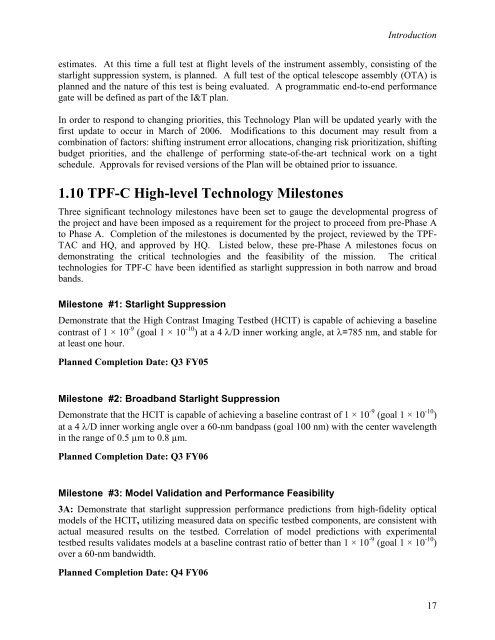TPF-C Technology Plan - Exoplanet Exploration Program - NASA
TPF-C Technology Plan - Exoplanet Exploration Program - NASA
TPF-C Technology Plan - Exoplanet Exploration Program - NASA
You also want an ePaper? Increase the reach of your titles
YUMPU automatically turns print PDFs into web optimized ePapers that Google loves.
Introduction<br />
estimates. At this time a full test at flight levels of the instrument assembly, consisting of the<br />
starlight suppression system, is planned. A full test of the optical telescope assembly (OTA) is<br />
planned and the nature of this test is being evaluated. A programmatic end-to-end performance<br />
gate will be defined as part of the I&T plan.<br />
In order to respond to changing priorities, this <strong>Technology</strong> <strong>Plan</strong> will be updated yearly with the<br />
first update to occur in March of 2006. Modifications to this document may result from a<br />
combination of factors: shifting instrument error allocations, changing risk prioritization, shifting<br />
budget priorities, and the challenge of performing state-of-the-art technical work on a tight<br />
schedule. Approvals for revised versions of the <strong>Plan</strong> will be obtained prior to issuance.<br />
1.10 <strong>TPF</strong>-C High-level <strong>Technology</strong> Milestones<br />
Three significant technology milestones have been set to gauge the developmental progress of<br />
the project and have been imposed as a requirement for the project to proceed from pre-Phase A<br />
to Phase A. Completion of the milestones is documented by the project, reviewed by the <strong>TPF</strong>-<br />
TAC and HQ, and approved by HQ. Listed below, these pre-Phase A milestones focus on<br />
demonstrating the critical technologies and the feasibility of the mission. The critical<br />
technologies for <strong>TPF</strong>-C have been identified as starlight suppression in both narrow and broad<br />
bands.<br />
Milestone #1: Starlight Suppression<br />
Demonstrate that the High Contrast Imaging Testbed (HCIT) is capable of achieving a baseline<br />
contrast of 1 × 10 -9 (goal 1 × 10 -10 ) at a 4 λ/D inner working angle, at λ=785 nm, and stable for<br />
at least one hour.<br />
<strong>Plan</strong>ned Completion Date: Q3 FY05<br />
Milestone #2: Broadband Starlight Suppression<br />
Demonstrate that the HCIT is capable of achieving a baseline contrast of 1 × 10 -9 (goal 1 × 10 -10 )<br />
at a 4 λ/D inner working angle over a 60-nm bandpass (goal 100 nm) with the center wavelength<br />
in the range of 0.5 µm to 0.8 µm.<br />
<strong>Plan</strong>ned Completion Date: Q3 FY06<br />
Milestone #3: Model Validation and Performance Feasibility<br />
3A: Demonstrate that starlight suppression performance predictions from high-fidelity optical<br />
models of the HCIT, utilizing measured data on specific testbed components, are consistent with<br />
actual measured results on the testbed. Correlation of model predictions with experimental<br />
testbed results validates models at a baseline contrast ratio of better than 1 × 10 -9 (goal 1 × 10 -10 )<br />
over a 60-nm bandwidth.<br />
<strong>Plan</strong>ned Completion Date: Q4 FY06<br />
17
















